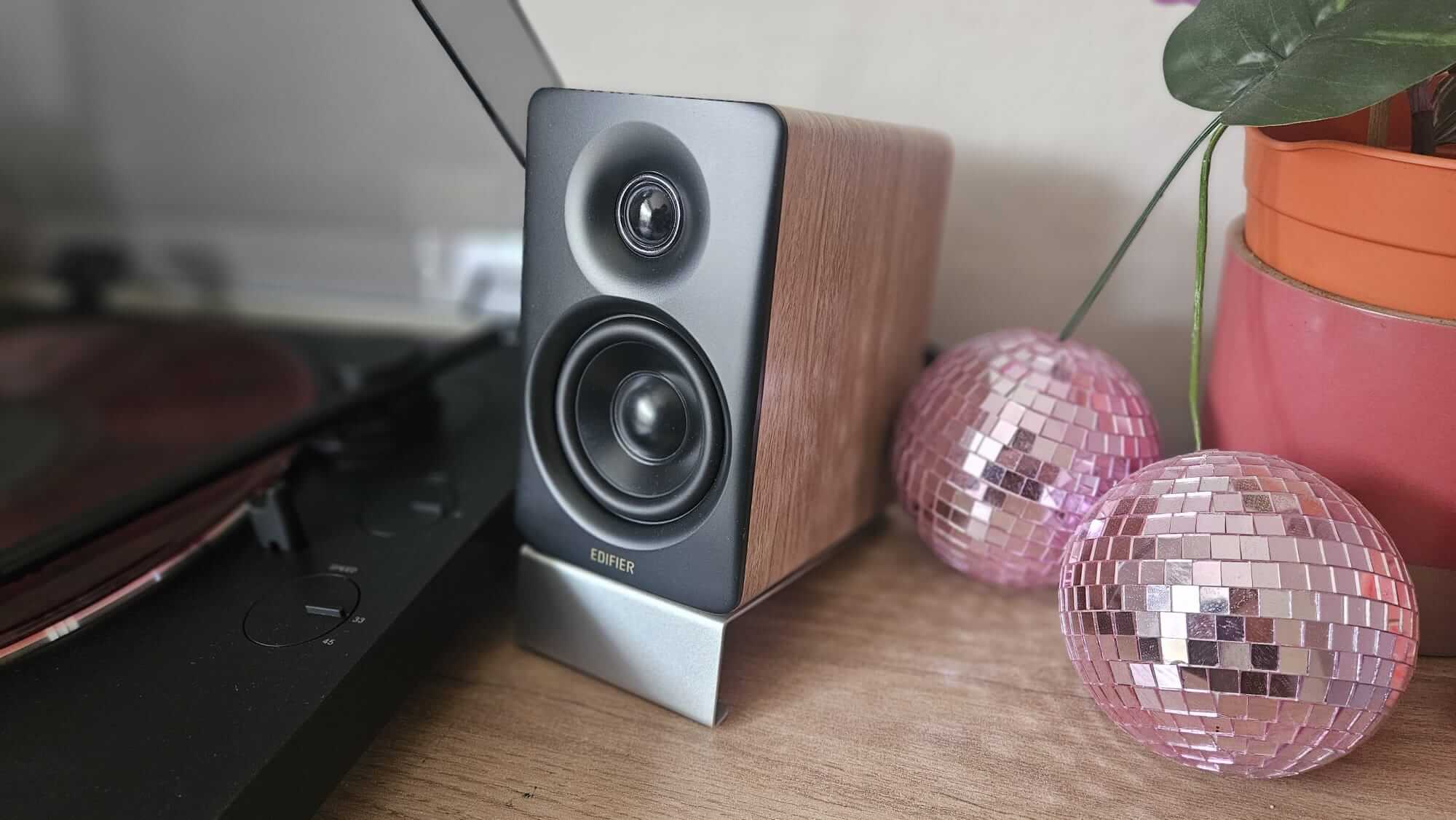
A few weeks back, we brought you news of a new set of speakers from the folks at Edifier, the M60s. We’re back now to bring you a full review. The Edifier M60 desktop speakers are designed to be compact while delivering a powerful listening experience.
Compact and Performant
First and foremost, I was very impressed with the simple and environmentally friendly packaging the speakers arrived in. Very little plastic, no polystyrene, and a minimalistic approach, made the unboxing quick and easy. Once they were out of the box and set up, it was time to start putting them through their paces.

Design
For the purpose of this review I received the classic oak variant of the Edifier M60s. Although full black, and white editions are also available. In terms of size, each single speaker without stand measures at 100 mm x 168 mm x 147 mm. If you want to imagine this size in your current setup, it’s roughly 6 Blu-ray cases stacked together. They’re a decent size to seamlessly slot into your current desk space or shelving setup. Weighing in at approximately 1.5 kg per speaker, sans stand, they won’t add a massive amount of strain, either.
My favourite feature of the design is the ‘invisible’ touch sensitive controls. This LED-lit panel sits atop the right speaker and allows you to control various aspects of playback, depending on which input you’re using. The controls are sensitive to touch, tap, and swipe gestures. The panel features a proximity sensor which allows the control elements, apart from the power indicator, to be unlit until used. Doubling its functionality, the power light also indicates which input is in use — blue for Bluetooth, red for USB, and green for AUX. While I’d definitely prefer a physical dial for quick volume control, I appreciate the sleekness of this design choice.

Connectivity
The Edifier M60s offer 3 connection options — Bluetooth 5.3, USB-C, and 3.5 mm stereo jack. Provided in the box are several cables for hooking up your audio equipment. These cables include a 1.5 m 3.5 mm to 3.5 mm, a 1.5 m RCA to 3.5 mm, and a 1 m USB-C to USB-C cable, giving you plenty of options for connectivity. Also included in the box are 2 silver, angled stands for the speakers, tilting them by 15 degrees to optimise sound delivery when placed on a desktop. All the connection ports are hosted on the right-hand speaker. This is also the speaker which connects to power via a 1.8 m figure-8 lead. The left-hand speaker is linked to the right-hand one via a 1.8 m cable, giving you enough length for most desks and shelving units.
I found the Bluetooth range to be impressive. When connected to my iPhone, the signal persisted without interference across several meters and rooms in the house. Conversely, my Sony WH-CN710N headset freaks out if I stand up from my seat to walk the short distance to my kitchen.
There’s no remote control provided, but the Edifier ConneX app can be used to control the Edifier M60 speakers when connected to a compatible mobile device. Using the app, you can switch the input and also adjust volume and equaliser settings. Updating firmware on the speakers is also done via the app, so it’s worth connecting it up as soon as they’re set up just for that.

Performance
Over the course of testing the M60s, I’ve used them in various scenarios. The first was hooked up to my record player, a Sony PS-LX310BT. Unfortunately, when using the AUX input option, I ran into issues with volume. This is because when using AUX, the volume needs to be controlled independently between devices and the record player doesn’t have volume controls. Bear that in mind if you intend to use these speakers with devices that are not Bluetooth enabled. When I switched to using Bluetooth instead, everything worked brilliantly. I’ve also connected the speakers to my phone and PC via Bluetooth, and the PC via AUX.
Under all circumstances, the sound has been great. I’ve tested a mix of music and video content, trying to cover as much ground as possible. To my amateur ears, the performance of the speakers has been faultless. In songs with elements spanning a range of frequencies, the clarity of sound was great. Equally, pumping the volume up on songs with deeper notes, like Hans Zimmer’s Time, didn’t incur any distortion. Ultimately, as compact desktop speakers, these are not intended for dedicated audiophiles and will definitely perform more than well enough for general use.

Conclusion
I’ve really enjoyed the Edifier M60 speakers — they’ve been a marked improvement over my cheap, existing Creative Pebbles. The Bluetooth range and quality means I can connect my phone and wander around the house doing chores without worrying about connection, or enjoy my records from another room rather than being limited to just the living room. They represent fantastic performance at a good price point. I’d certainly recommend the M60s to anyone enquiring about a small set of desktop speakers.
The Edifier M60 Compact Desktop 2.0 Speakers receive a Thumb Culture Gold Award.

Disclaimer: A sample was received in order to write this review.

YouTube | Facebook | Twitter | Instagram | Discord | Podcast
